The Islamic necropolis of Shah-i-Zinda in Samarkand,an Islamic World Heritage Site

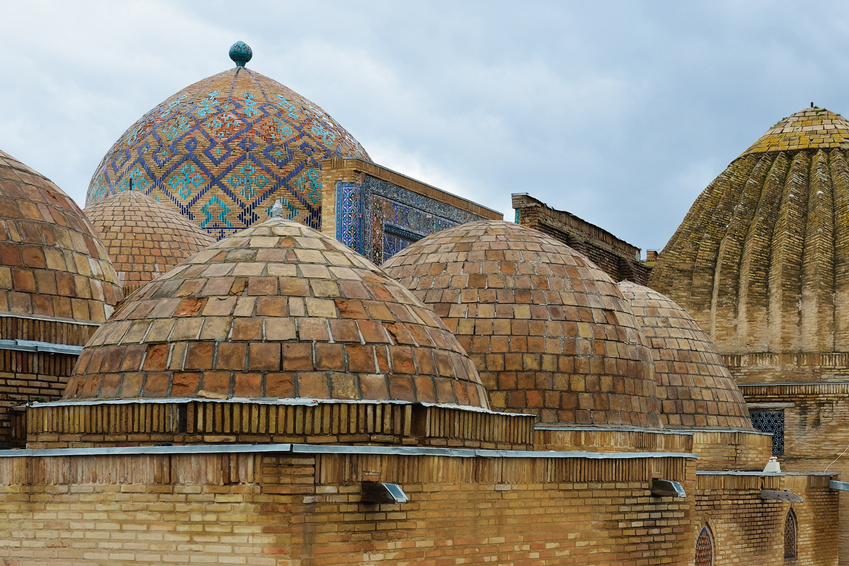
The steppes. In the middle, Samarkand, Uzbekistan. Dreams of voyages would be but immobile. Due to their non-figurative character, the Islamic works of art have something of a pure beauty. Latticework, mosaics... the blue, of course.
Voyage to the land of Samarkand.
The necropolis of Shah-i-Zinda is situated in Samarkand, the capital of the empire founded by Timur in central and western Asia. It is a vast architectural ensemble composed of eleven mausoleums. We call the necropolis the Living king, because of the existence of a legend linked to the death of Kusam ibn Abbas, cousin of the Prophet, protector of Samarkand and an Islamic saint.
Kusam ibn Abbas arrived in Samarkand in the 7th century with the Arab invasion. He preached Islam and was buried there. According to legend, he was decapitated for his faith but, somehow still keeping his head, he was admitted to the Garden of Paradise, where he lives on.
Built in the 11th century, the mausoleum of the saint becomes the object of a regular pilgrimage, and after the temporary abandonment of the site due to the Mongolian invasion, which destroyed ancient Samarkand in its entirety, the Timurid family had several mausoleums and buildings constructed, principally under the reign of Timur, but also under that of the son of the conquerer, Ulugbek. Timur's successors endured numerous revolts, but they appear to have been enlightened sovereigns, as an interest for the sciences and the arts drove to a brief cultural blossoming over the course of the 15th century, the Timurid Renaissance. The Timurid empire soon after fell to the hands of the Uzbek descendants of Genghis Khan.
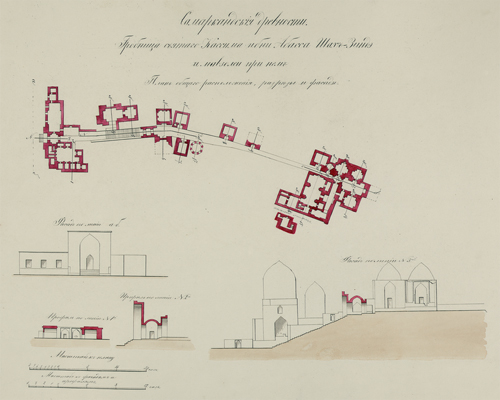
Layout of the Islamic necropolis of Shah-i-Zinda
Today, the necropolis counts nearly 20 monuments. There we find works of an exceptional beauty and variety, from the octagonal mausoleum of Kusam ibn Abbas, to the two blue cupolas of the mausoleum of Kazi Zade Rumi. The mausoleums are aligned along the length of a pathway, constructed on a hillside in the lower part of the complex. Three gateways or vaulted spaces (tchortok) punctuate this funeral road.
The mausoleums of the central group: to the left, the octagonal mausoleum (15th century), to the right the mausoleum of Alim Nesefi (1385).
The octagonal mausoleum is that of Kusam ibn Abbas. It was the first to be constructed, in the 11th century, and was later restructured in the 14th century, when it was transformed into the principal site of the city's saint.
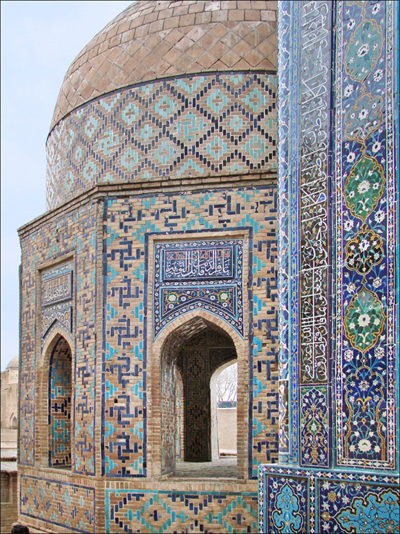
Octagonal mausoleum
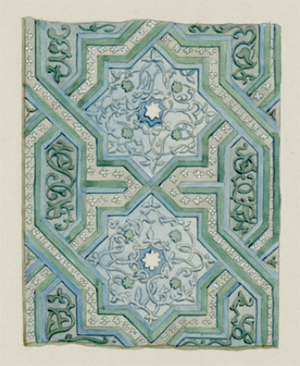
Detail of the facade (found on the octagon)
Anonymous mausoleum which was given the name of the architect Alim Nesefi
This mausoleum was constructed by the master Alim Nesefi (Alim Nasafi, Ali from Nasaf) in 1385. The decoration uses majolica paints and engravings that have replaced the terra cotta.
Alim Nesefi's Mausoleum
Gateway to the mausoleum of Alim Nesefi
The Timurid mausoleums of the 14th and 15th centuries
Gateway to the Mausoleum of Koutloug Aka
This mausoleum was constructed from 1360-1361 for one of the wives of Timur (Amir Timur)
Gateway to the Mausoleum of Koutloug Aka
The two blue cupolas of the mausoleum of Kazi Zade Rumi (1420-1425)
Kazi Zade Rumi or Qazi Zadeh Roumi was the tutor of Ulugbek, but in the mausoleum attributed to the son of Ulugbek, it seems that there are the remains of a woman (Timur's nanny, according to certain guides).
The two blue cupolas of the mausoleum of Kazy Zade Roumi
Mausoleums of the northern group - To the left, the mosque of Touman Aka, to the right the tchortak (passage)
Mausoleums of the Northern group
We find in these works the elements characteristic to Islamic art: calligraphy (Arabic script assures the unity of all the Islamic civilization), the attention paid to the decorative, arabesque plants, the importance of geometry. We find not one human or animal representation (outlawed from appearing on religious buildings). The different gates are practically monumental, as they often are in Islamic art.
The necropolis was the object of successive restorations over the course of the 20th century.
Interior decorations:

Interior décor of the mausoleum of Shirin Bika Aka
Mausoleum of Shirin Bika Aka
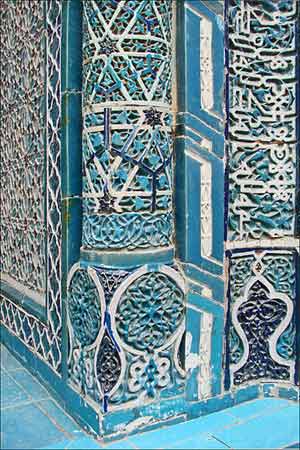
Mausoleum of Khodja Akhmad
Decorative sign of the gateway to the mausoleum of Touman Aka (1404-1405)
Touman Aka was the favorite young wife of Timur. Her mausoleum is richly decorated with mosaics of geometric decorations.
Decorative sign of the gateway to the mausoleum of Touman Aka
The mausoleum of Shirin Bika Aka
The Shirin Bika Aka masoleum, dating to 1385, commemorates one of Timur's sisters. The base of its cupola counts 16 sides. Its dark blue mosaic, openwork decoration is in Iranian or Azerbaijanian style. It has been recently restored.
The cupola of the mausoleum of Shirin Bika Aka
Julien Guerraz
Thanks to Lisa for the translation from the French to the English
www.mneseek.fr (partage de liens internet culturels)



